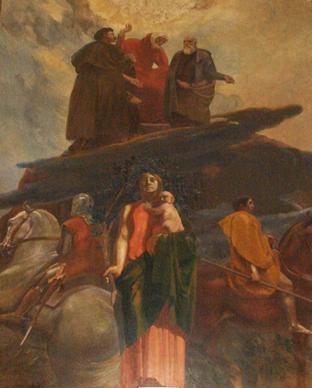Doves, scales, olive branches, swords and many ladies justice in paintings, sculptures, tiles and panels adorn the halls of the Peace Palace. These symbols of peace emphasize the essence of the foundation of the building and the institutions it houses. A very fine example is the painting by Albert Besnard (1849-1934): La Paix et la Justice, 1914. It measures 6 x 5 meters and hangs in the Great Hall of Justice in the Peace Palace, the courtroom where the hearings of the International Court of Justice are held. La Paix et la Justice (Peace and Justice), was an official gift of France to the Peace Palace.
In the painting, Peace and Justice are represented as follows: in the upper part of the art work, in the sky, the scales of justice are seen, the traditional symbol of Justice. Below, Justice is depicted as a woman dressed in red. Justice is listening to the pleadings of the lawyers standing next to her. The lawyer seen on the left is pleading with passion and wild hand gestures. The lawyer on the right side has a patriarchal appearance, pleading in a calm way. At the lower part of the painting, the goddess of Peace, Irene, is depicted carrying a child, Plutus, god of Prosperity, and an olive branch, a symbol of peace and victory. The warriors on their horses represent the parties in conflict leaving the battle. The lady of Peace keeps them apart and sends them on their way.
The Musée D’Orsay in Paris owns a study of this painting titled: La Paix par L’arbitrage, but we know that the painting in the Peace Palace bears the title: La Paix et La Justice. An explanation of the fact that the title of the work of art has changed along the way could be, that at the time the painting was executed (1914) the Great Hall was used by the Permanent Court of Arbitration but when it was actually placed on the wall in the Great Hall in 1926, the room was already in use by the Permanent Court of International Justice.
